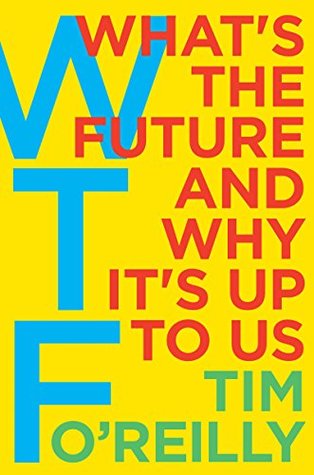More on this book
Community
Kindle Notes & Highlights
by
Tim O'Reilly
Read between
February 4 - April 7, 2019
Pursue something so important that even if you fail, the world is better off for you having tried.
That is the right way to use capital markets. Enriching investors, if it happens, will be a by-product of what he does, not his goal. He is harnessing all the power of money and technology to do something that today is impossible.
CREATE MORE VALUE THAN YOU CAPTURE.
Look around you: How many people do you employ in fulfilling jobs? How many customers use your products to make their own living? How many competitors have you enabled? How many people have you touched who gave you nothing back?
TAKE THE LONG VIEW.
Our economy has many elements of a Ponzi scheme. We borrow from other countries to finance our consumption, and we borrow from our children by saddling them with debt, using up nonrenewable resources, and failing to confront great challenges in income inequality, climate change, and global health.
It’s essential to get beyond the idea that the only goal of business is to make money for its shareholders. I’m a strong believer in the social value of business done right. We should aim to build an economy in which the important things are a natural outcome of the way we do business, paid for in self-sustaining ways rather than as charities to be funded out of the goodness of our hearts.
it’s important to think about the big picture, and what matters not just to us, but to building a sustainable economy in a sustainable world.
ASPIRE TO BE BETTER TOMORROW THAN YOU ARE TODAY.
Scenario planning takes for granted that the future is uncertain. But it also notes that there are deep trends shaping the future that we can observe and take into account.
Scenario planning takes for granted that it is hard for human beings to imagine the future as being radically different from the present. As a result, its practitioners don’t try to predict the future; they work to prepare companies and countries to develop “robust strategies” that work in the face of radically different futures.
The goal is not to identify what will happen, but to stretch the mind to think about what might happen. A scenario-planning exercise therefore asks participants to imagine four radically different futures that could come about as a result of current trends. As Peter Schwartz, one of the originators of the technique, wrote in the introduction to his book about it, The Art of the Long View, the scenario is “a vehicle . . . for an imaginative leap into the future.”
In a scenario-planning exercise, the vectors are drawn in such a way that they cross each other and divide the possibility space into quadrants.
Whether you’re in business or public policy, don’t settle for rehashing tired solutions. Keep looking for that positive astonishment that means you’ve accomplished something wonderful for the people you serve.
First, never use a one-size-fits-all decision-making process. Many decisions are reversible, two-way doors. Those decisions can use a light-weight process. For those, so what if you’re wrong? . . . Second, most decisions should probably be made with somewhere around 70% of the information you wish you had. If you wait for 90%, in most cases, you’re probably being slow. Plus, either way, you need to be good at quickly recognizing and correcting bad decisions. If you’re good at course correcting, being wrong may be less costly than you think, whereas being slow is going to be expensive for sure.
...more
“Work,” not “jobs,” should be the organizing principle for our map of the future labor economy. There is plenty of work to be done.
It isn’t technology that puts people out of work; it’s the decisions we make about how to apply it.
This is my faith in humanity: that we can rise to great challenges. Moral choice, not intelligence or creativity, is our greatest asset. Things may get much worse before they get better. But we can choose instead to lift each other up, to build an economy where people matter, not just profit. We can dream big dreams and solve big problems. Instead of using technology to replace people, we can use it to augment them so they can do things that were previously impossible.


